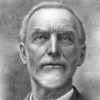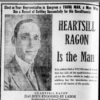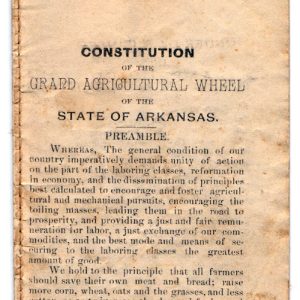calsfoundation@cals.org
Populist Movement
aka: People's Party
aka: Populism
During the last three decades of the nineteenth century, American farmers faced a variety of economic problems including rising business costs, a scarcity of credit, and falling crop prices. Frustrated farmers formed organizations to address such problems and ultimately turned to independent or third-party politics. These efforts coalesced in the 1890s with the founding of the People’s (or Populist) Party, which drew most of its support in the West and the South. In Arkansas, the third-party movement actually peaked between 1888 and 1890 under the guise of the Union Labor Party (ULP), which lasted fewer years than the Populist Party but won more support, unlike in other states.
Origins of the Populist Movement
The organized farmers’ movement in Arkansas began in 1872 with the Patrons of Husbandry (more commonly known as the Grange). This national organization provided members with social and educational benefits and promoted cooperative purchasing and selling enterprises. At its peak in 1876, the Arkansas State Grange claimed over 20,000 members, but this figure rapidly declined as the organization’s cooperative enterprises failed. In 1878, the fading State Grange, although officially nonpartisan, gave its stamp of approval to the inflationary, soft-money platform of the Greenback Party, which captured few political offices in Arkansas but did suggest the willingness of some farmers to support a third party.
Unlike the Grange, the next two groups to organize Arkansas farmers came from within the state: the Agricultural Wheel, formed in Prairie County in 1882, and the Brothers of Freedom, formed in Johnson County during the same year. These groups followed the Grange in establishing cooperative enterprises and in condemning monopolies and trusts as sources of farmers’ economic troubles, but they also proved more inclined to enter the political arena. In 1884, both organizations supported independent political candidates (occasionally in cooperation with the then-hapless Arkansas Republican Party), winning local races in at least seven counties and electing fifteen of the state’s 127 state legislators. In October 1885, the Brothers and the Agricultural Wheel consolidated, retaining the name of the latter organization, and by August 1886, the Wheel claimed some 55,000 members in Arkansas and had begun spreading into other states. In 1886, the Wheel nominated a state ticket and three congressional candidates, with unofficial support from the Knights of Labor, which claimed at least 2,986 members in the state at the time. These efforts also produced negligible results but laid the groundwork for more significant challenges to follow shortly.
The Union Labor Party
The ULP would become the strongest outlet for farmer-labor political protest in Arkansas during the late nineteenth century. Formed in Cincinnati, Ohio, in February 1887, the ULP never amounted to much nationally, but it presented the Arkansas Democratic Party with its greatest challenge of the post-Reconstruction era. The ULP’s major demands foreshadowed those of the Populist Party, most notably governmental ownership of the means of communication and transportation, the free coinage of silver, and policies that would discourage land speculation. The Arkansas ULP provided stiff opposition for Democrats in state and congressional elections in 1888, buttressed by the lack of Republican nominees in the former and some of the latter. ULP candidate Charles M. Norwood polled nearly forty-six percent of the vote in the gubernatorial election of 1888, according to official returns. Norwood and his supporters, however, contended that Democrats had in fact robbed him of victory through fraud and violence, a charge with which historians have since concurred. Initial returns showed a Democratic sweep in the congressional races, but two of these disputed elections were decided by the U.S. House of Representatives, which declared Union Laborite L. P. Featherstone and the Wheel-supported Republican John M. Clayton victorious in the state’s First and Second districts, respectively. Clayton never entered Congress, however: he was assassinated in Conway County, apparently by local Democrats, while gathering evidence for his case. In 1890, ULP state and congressional candidates again lost close contests that were marred by fraud and violence.
The Arkansas People’s Party
The ULP became the People’s (or Populist) Party in Arkansas in 1891 upon the formation of the national People’s Party. The Populists nominated J. P. Carnahan for governor and, in an obvious reference to lynchings, condemned the state’s Democrats for encouraging a “spirit of mob law.” Little could have Arkansas Populist leaders known that their opportunity had already passed (or been stolen by Democrats). The state’s “election reform” law of 1891 virtually disfranchised those Arkansans who could not read, which included seventeen percent of white men and sixty-four percent of black men age twenty or over, according to the census of 1890. Furthermore, the state’s Republican Party decided to reenter the fray in state elections in 1892, which undoubtedly cost the Populists votes among those African Americans who could indeed still vote. The Populist state ticket finished third that year, and the party never elected either a state-wide officer or congressman in Arkansas. After 1900, it stopped trying.
The Populist Legacy
A small minority of Arkansas farm and labor leaders who had been Populists became active in the Socialist Party in the early twentieth century, including 1898 Populist gubernatorial candidate W. Scott Morgan. A greater legacy of the Populist movement in Arkansas, however, lies in its impact upon the state’s Democratic Party, which entered a long period of political dominance after vanquishing the third-party challenge. Even in the 1890s, as Arkansas Democrats were finishing their rather undemocratic conquest of Populism, they became supporters of “free silver” and the regulation of railroads and other corporations that farmers had long decried as “trusts” and “monopolies.” No one personified this Democratic absorption of the Populist spirit better than Jeff Davis, who served as Arkansas’s governor from 1901 to 1907. Yet, in another sense, the legacy of the Populist movement in Arkansas is that of democracy betrayed; few case studies in American history could better illustrate the brutal destruction of political dissent and how the one-party “Solid South” emerged at the close of the nineteenth century than that of Arkansas’s Populist movement.
For additional information:
Barnes, Kenneth C. Who Killed John Clayton? Political Violence and the Emergence of the New South, 1861–1893. Durham, NC: Duke University Press, 1998.
Baskett, Thomas S., Jr. “Miners Stay Away!: W. B. W. Heartsill and the Last Years of the Arkansas Knights of Labor, 1892–1896.” Arkansas Historical Quarterly 42 (Summer 1983): 107–133.
Hild, Matthew. Arkansas’s Gilded Age: The Rise, Decline, and Legacy of Populism and Working-Class Protest. Columbia: University of Missouri Press, 2018.
———. Greenbackers, Knights of Labor, and Populists: Farmer-Labor Insurgency in the Late-Nineteenth-Century South. Athens: University of Georgia Press, 2007.
———. “Labor, Third-Party Politics, and New South Democracy in Arkansas, 1884–1896.” Arkansas Historical Quarterly 63 (Spring 2004): 24–43.
———. “The Populist Movement and Nightriding in Arkansas.” Arkansas Historical Quarterly 81 (Autumn 2022): 241–251.
Moneyhon, Carl H. Arkansas and the New South, 1874–1929. Fayetteville: University of Arkansas Press, 1997.
Wheeler, John M. “The People’s Party in Arkansas, 1891–1896.” PhD diss., Tulane University, 1975.
Matthew Hild
Georgia Institute of Technology
 Cunningham, Charles E.
Cunningham, Charles E. Heartsill, Willie Blount Wright (W. B. W.)
Heartsill, Willie Blount Wright (W. B. W.) Labor Movement
Labor Movement Post-Reconstruction through the Gilded Age, 1875 through 1900
Post-Reconstruction through the Gilded Age, 1875 through 1900 Sovereign, James Richard
Sovereign, James Richard Agricultural Wheel Constitution
Agricultural Wheel Constitution 




Comments
No comments on this entry yet.